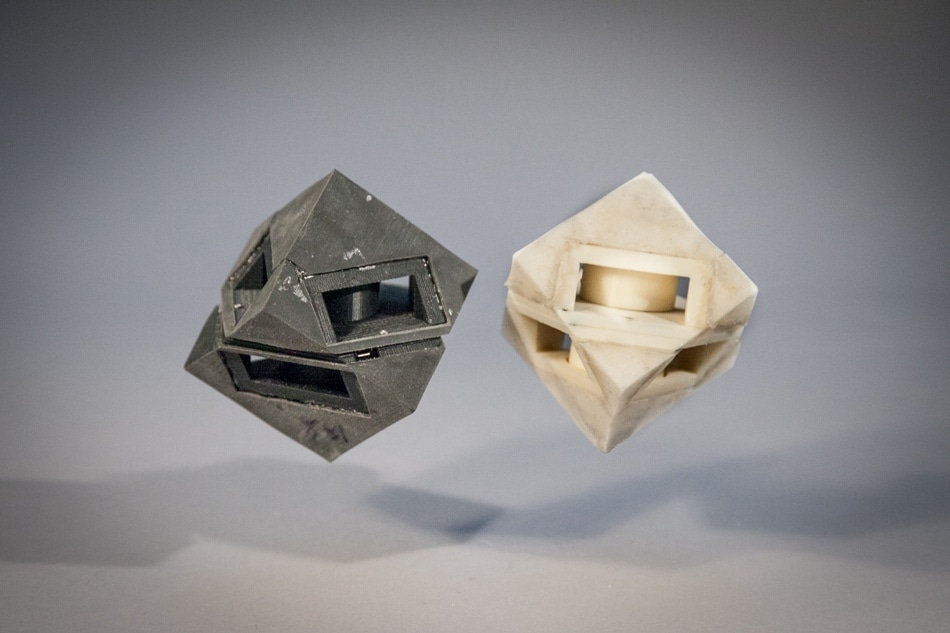Oct 4 2016
 MIT researchers outfitted their cube robot with shock-absorbing “skins” (left) that transfer less than half of the energy that would normally be transferred to the ground. (Credit: Jason Dorfman/MIT CSAIL)
MIT researchers outfitted their cube robot with shock-absorbing “skins” (left) that transfer less than half of the energy that would normally be transferred to the ground. (Credit: Jason Dorfman/MIT CSAIL)
Those who have ever watched an episode of ‘BattleBots’ or drone videos would know that robots can break, and this is often due to the lack of proper padding to protect them.
Scientists from MIT’s Computer Science and Artificial Intelligence Laboratory (CSAIL) will present a new method of 3D printing soft materials, which can be used to increase the safety of robots and make their movements more precise, and enhance the durability of helmets, shoes, phones, and drones, among other things. The presentation will happen in the first week of October, 2016.
Users can program all of the parts of a 3D printed object to the desired level of elasticity and stiffness based on the task at hand, using the “programmable viscoelastic material” (PVM) technique developed by the researchers.
For example, the researchers developed and outfitted a cube robot with shock-absorbing “skins,’ which utilize only 1/250 the level of energy it transfers to the floor.
That reduction makes all the difference for preventing a rotor from breaking off of a drone or a sensor from cracking when it hits the floor. These materials allow us to 3-D print robots with visco-elastic properties that can be inputted by the user at print-time as part of the fabrication process.
Daniela Rus, Director, CSAIL
With the skins, the robot can also achieve a landing that is four times more precise. This indicates that similar shock-absorbing skins can be employed to increase the lifespan of delivery drones, such as the ones used by Google and Amazon.
A paper detailing the research will be presented at the IEEE/RSJ International Conference on Intelligent Robots and Systems, to be held in Korea in October. Rus authored the paper alongside lead authors Robert MacCurdy and Jeffrey Lipton, and Shuguang Li, all of whom are postdocs.
Putting a Damper on Things
Dampers are used for various purposes such as controlling piano notes, keeping car tires on the road, and protecting radio towers and other such structures from storms.
“Viscoelastics” such as plastic and rubber that posses both solid and liquid characteristics are the most commonly used dampers. Viscoelastics are compact, easy to find and inexpensive. However, they are commercially available only at particular damping levels and particular sizes as customizing them is a very time-consuming process.
The team realized that 3D printing is the solution to this issue. 3D printing enables users to “program” materials to suit their requirements for all parts as one can place materials with different mechanical qualities in a design.
It’s hard to customize soft objects using existing fabrication methods, since you need to do injection moulding or some other industrial process. 3-D printing opens up more possibilities and lets us ask the question, ‘can we make things we couldn’t make before?
Jeffrey Lipton, Postdoc, MIT
The researchers printed the cube and the skins using a flexible rubber-like material known as TangoBlack+, a liquid and a solid, by employing a standard 3D printer. The PVM process is based on an earlier 3D printed robotics project of Rus, where an inkjet deposits various materials layer-by-layer, and later, solidifies the non-liquids using UV light.
The cube robots have two motors, battery, a microcontroller, inertial measurement unit sensors and a rigid body. The cube is propelled by strings made of four layers of metal stripes looped together.
“By combining multiple materials to achieve properties that are outside the range of the base material, this work pushes the envelope of what’s possible to print,” says professor of engineering at Columbia University, Hod Lipson who co-authored ‘Fabricated: The New World of 3-D Printing.’ “On top of that, being able to do this in a single print-job raises the bar for additive manufacturing.”
Rus states that the PVMs can be used for many other protective purposes such as shock-absorbing headgear and running shoes. The PVMs do not only protect cameras, sensors and other sensitive parts of the robot by motion caused by the motors, but can also provide more control over the robots.
“Being able to program different regions of an object has important implications for things like helmets,” says MacCurdy. “You could have certain parts made of materials that are comfortable for your head to rest on, and other shock-absorbing materials for the sections that are most likely to be impacted in a collision.”
A National Science Foundation grant has funded the study.
Programmable Viscoelastic Materials
Shock-absorbing skins allow these robots from MIT's Computer Science and Artificial Intelligence Laboratory to land more precisely. One potential application: Extending the lifespan of delivery drones like those being developed by Amazon and Google. (Video: MIT CSAIL)